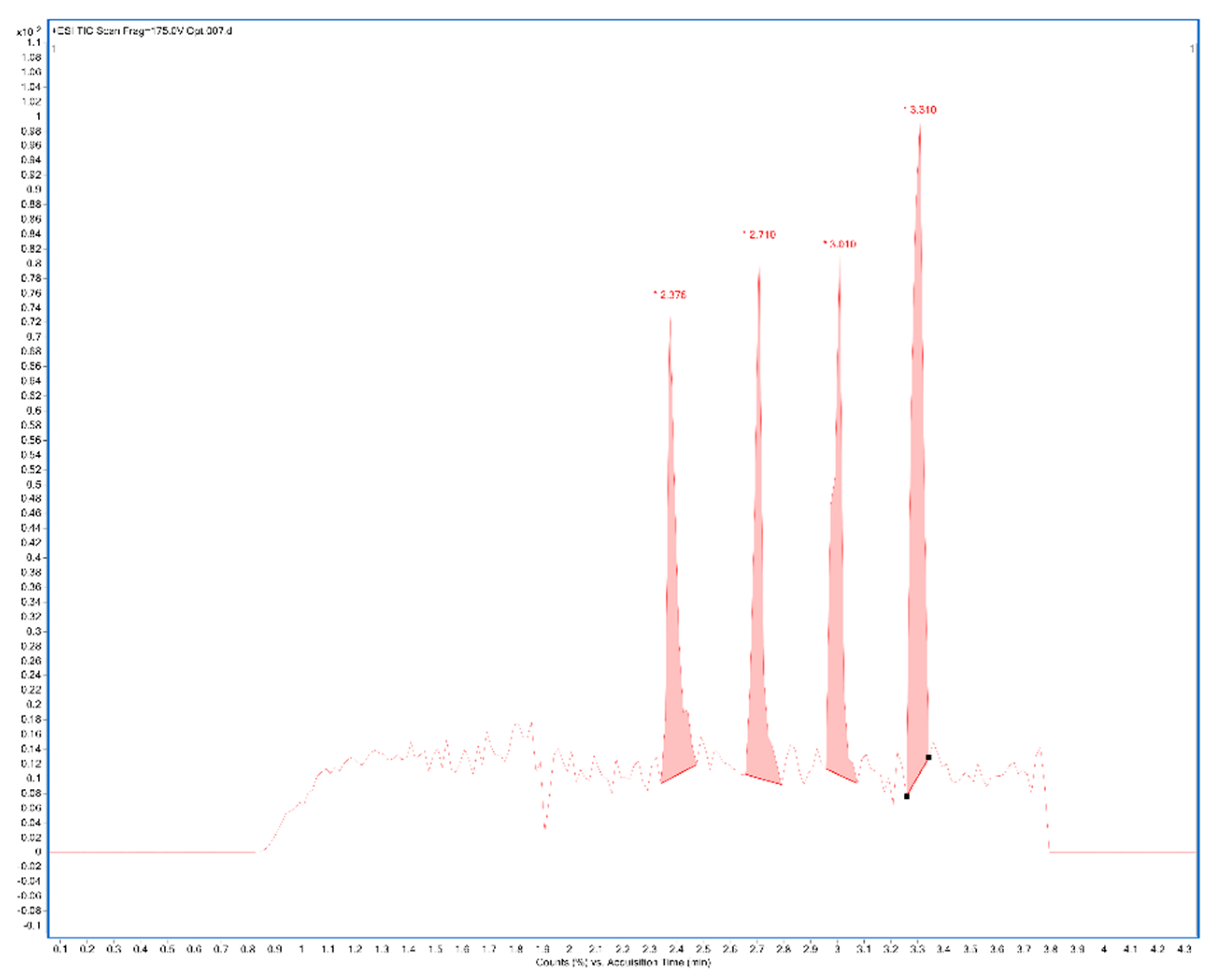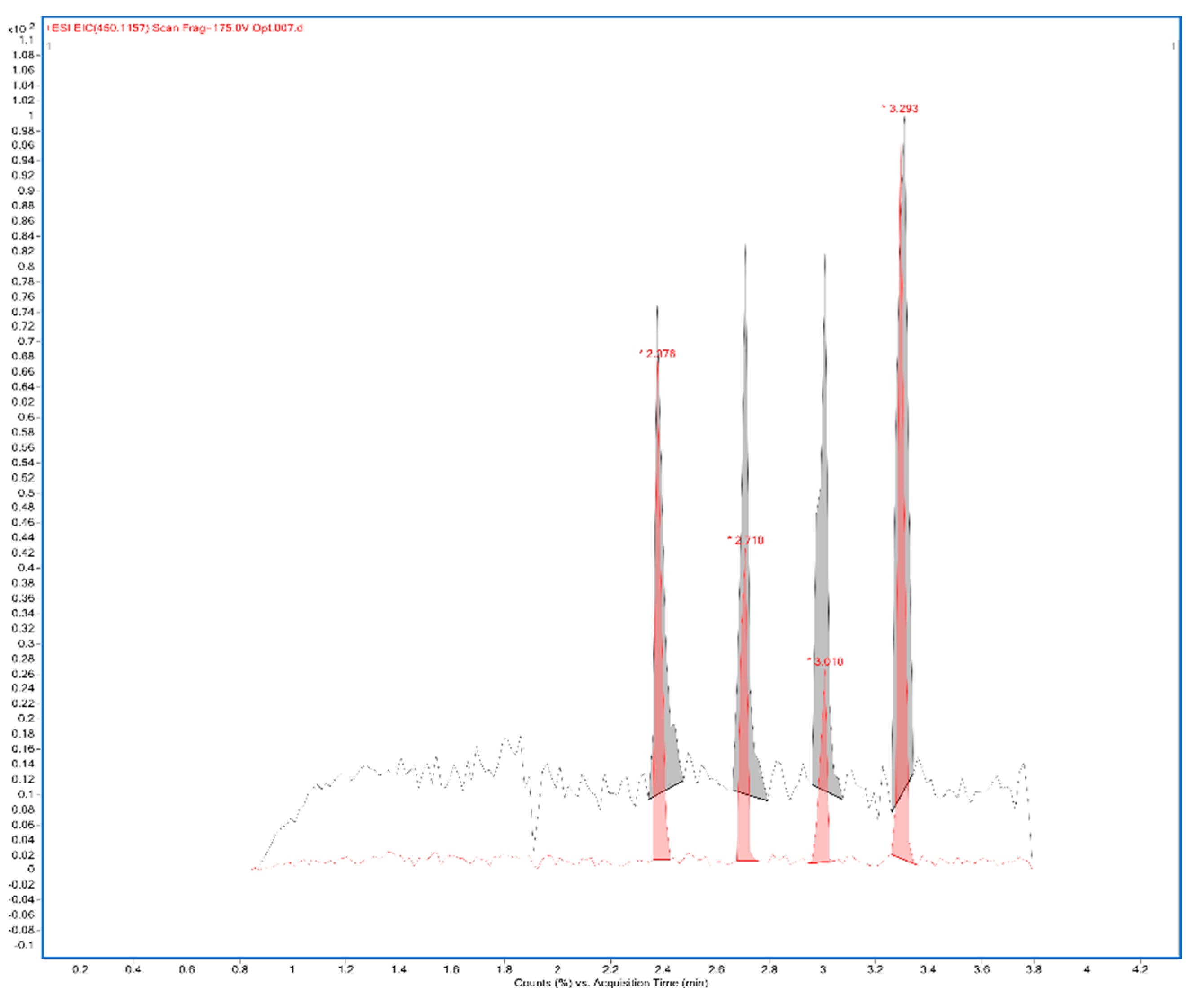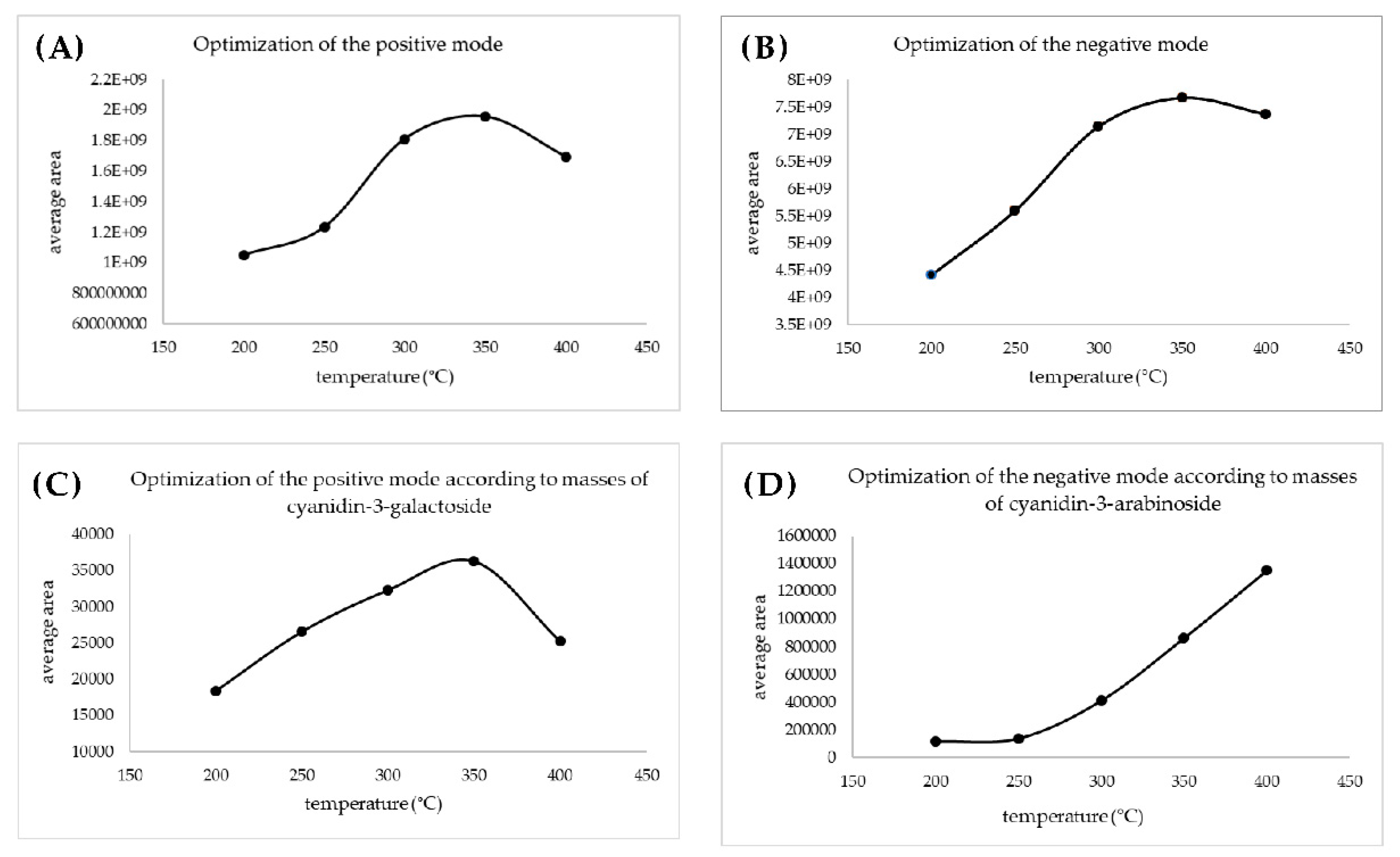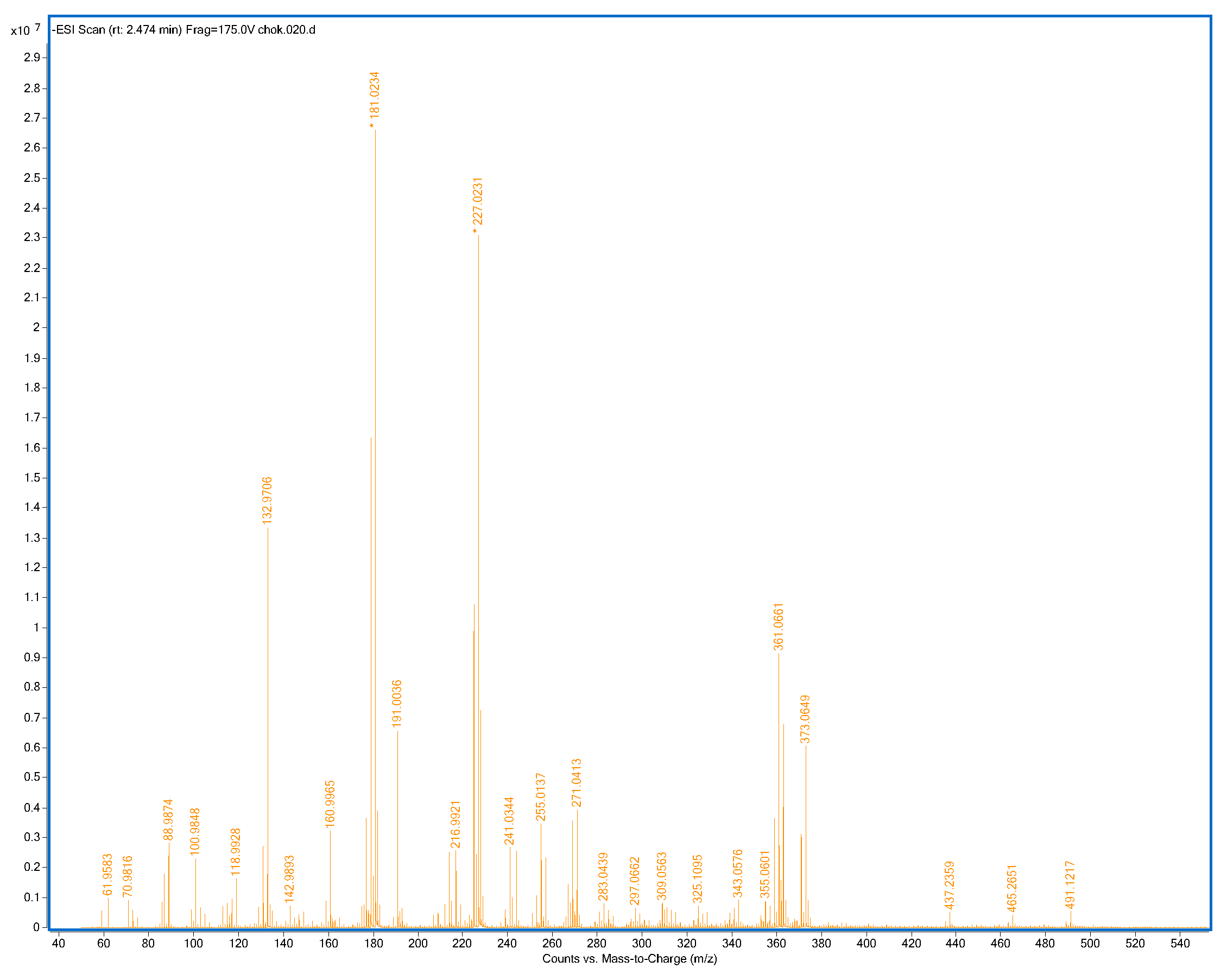Evaluation of Chokeberry/Carboxymethylcellulose Hydrogels with the Addition of Disaccharides: DART-TOF/MS and HPLC-DAD Analysis
Abstract
1. Introduction
2. Results and Discussion
2.1. Optimization of the DART-TOF/MS Method and DART-TOF/MS Analysis
2.2. Polyphenols and Antioxidant Activity of Chokeberry Juice
2.3. Evaluation of Polyphenols in Hydrogels
2.4. Evaluation of Antioxidant Activity of Hydrogels
3. Materials and Methods
3.1. Chemicals
3.2. Preparation of Samples
3.3. Extraction of Polyphenols
3.4. Direct Analysis in Real-Time Ionization with Time-Of-Flight Mass Spectrometry (DART/TOF-MS) Analysis
3.5. Determination of Total Polyphenols, Monomeric Anthocyanins, and Antioxidant Activity
3.5.1. Total Polyphenols and Monomeric Anthocyanins
3.5.2. Antioxidant Activity (ABTS, DPPH, CUPRAC, FRAP Assays)
3.6. High-Performance Liquid Chromatography-Diode Array Detection (HPLC-DAD) Method
3.7. Statistical Analysis
4. Conclusions
Author Contributions
Funding
Institutional Review Board Statement
Informed Consent Statement
Data Availability Statement
Acknowledgments
Conflicts of Interest
References
- Kapci, B.; Neradová, E.; Čížková, H.; Voldřich, M.; Rajchl, A.; Capanoglu, E. Investigating the antioxidant potential of chokeberry (Aronia melanocarpa) products. J. Food Nutr. Res. 2013, 52, 219–229. [Google Scholar]
- Nowak, D.; Gośliński, M.; Wojtowicz, E. Comparative analysis of the antioxidant capacity of selected fruit juices and nectars: Chokeberry juice as a rich source of polyphenols. Int. J. Food Prop. 2015, 19, 1317–1324. [Google Scholar] [CrossRef]
- Jurendić, T.; Ščetar, M. Aronia melanocarpa products and by-products for health and nutrition: A review. Antioxidants 2021, 10, 1052. [Google Scholar] [CrossRef] [PubMed]
- Zhang, Y.; Zhao, A.; Liu, X.; Chen, X.; Ding, C.; Dong, L.; Zhang, J.; Sun, S.; Ding, Q.; Khatoom, S.; et al. Chokeberry (Aronia melanocarpa) as a new functional food relationship with health: An overview. J. Future Foods 2021, 1, 168–178. [Google Scholar] [CrossRef]
- Jakobek, L.; Matić, P.; Ištuk, J.; Barron, A.R. Study of interactions between individual phenolics of aronia with barley beta- glucan. Pol. J. Food Nutr. Sci. 2021, 71, 187–196. [Google Scholar] [CrossRef]
- Ghendov-Mosanu, A.; Cristea, E.; Sturza, R.; Niculaua, M.; Patras, A. Synthetic dye’s substitution with chokeberry extract in jelly candies. J. Food Sci. Technol. 2020, 57, 4383–4394. [Google Scholar] [CrossRef]
- Zhu, Y.; Zhang, J.; Wei, Y.; Hao, J.; Lei, Y.; Zhao, W.; Xiao, Y.; Sun, A. The polyphenol-rich extract from chokeberry (Aronia melanocarpa L.) modulates gut microbiota and improves lipid metabolism in diet-induced obese rats. Nutr. Metab. 2020, 17, 54. [Google Scholar] [CrossRef]
- Yamane, T.; Kozuka, M.; Wada-Yoneta, M.; Sakamoto, T.; Nakagaki, T.; Nakano, Y.; Ohkubo, I. Aronia juice suppresses the elevation of postprandial blood glucose levels in adult healthy Japanese. Clin. Nutr. Exp. 2017, 12, 20–26. [Google Scholar] [CrossRef]
- Gill, N.K.; Rios, D.; Osorio-Camacena, E.; Mojica, B.E.; Kaur, B.; Soderstrom, M.A.; Gonzalez, M.; Plaat, B.; Poblete, C.; Kaur, N.; et al. Anticancer Effects of Extracts from Three Different Chokeberry Species. Nutr. Cancer 2020, 73, 1168–1174. [Google Scholar] [CrossRef]
- Denev, P.; Číž, M.; Kratchanova, M.; Blazheva, D. Black chokeberry (Aronia melanocarpa) polyphenols reveal different antioxidant, antimicrobial and neutrophil-modulating activities. Food Chem. 2019, 284, 108–117. [Google Scholar] [CrossRef]
- Micale, N.; Citarella, A.; Molonia, M.S.; Speciale, A.; Cimino, F.; Saija, A.; Cristani, M. Hydrogels for the delivery of plant-derived (poly)phenols. Molecules 2020, 25, 3254. [Google Scholar] [CrossRef] [PubMed]
- Ćorković, I.; Pichler, A.; Šimunović, J.; Kopjar, M. Hydrogels: Characteristics and application as delivery systems of phenolic and aroma compounds. Foods 2021, 10, 1252. [Google Scholar] [CrossRef] [PubMed]
- Zhang, Y.; Dong, L.; Liu, L.; Wu, Z.; Pan, D.; Liu, L. Recent Advances of Stimuli-Responsive Polysaccharide Hydrogels in Delivery Systems: A Review. J. Agric. Food Chem. 2022, 70, 6300–6316. [Google Scholar] [CrossRef] [PubMed]
- Rahman, M.S.; Hasan, M.S.; Nitai, A.S.; Nam, S.; Karmakar, A.K.; Ahsan, M.S.; Shiddiky, M.J.A.; Ahmed, M.B. Recent Developments of Carboxymethyl Cellulose. Polymers 2021, 13, 1345. [Google Scholar] [CrossRef] [PubMed]
- Ćorković, I.; Pichler, A.; Buljat, I.; Šimunović, J.; Kopjar, M. Carboxymethylcellulose hydrogels: Effect of its different amount on preservation of tart cherry anthocyanins and polyphenols. Curr. Plant Biol. 2021, 22, 100222. [Google Scholar] [CrossRef]
- Kopjar, M.; Piližota, V.; Hribar, J.; Simčič, M.; Zlatič, E.; Nedić Tiban, N. Influence of trehalose addition and storage conditions on the quality of strawberry cream filling. J. Food Eng. 2008, 87, 341–350. [Google Scholar] [CrossRef]
- Kopjar, M.; Pichler, A.; Turi, J.; Piližota, V. Influence of trehalose addition on antioxidant activity, colour and texture of orange jelly during storage. Int. J. Food Sci. Technol. 2016, 51, 2640–2646. [Google Scholar] [CrossRef]
- Vukoja, J.; Buljeta, I.; Ivić, I.; Šimunović, J.; Pichler, A.; Kopjar, M. Disaccharide Type Affected Phenolic and Volatile Compounds of Citrus Fiber-Blackberry Cream Fillings. Foods 2021, 10, 243. [Google Scholar] [CrossRef]
- Lončarić, A.; Pichler, A.; Trtinjak, I.; Piližota, V.; Kopjar, M. Phenolics and antioxidant activity of freeze-dried sour cherry puree with addition of disaccharides. LWT 2016, 73, 391–396. [Google Scholar] [CrossRef]
- Kopjar, M.; Buljeta, I.; Nosić, M.; Ivić, I.; Šimunović, J.; Pichler, A. Encapsulation of blackberry phenolics and volatiles using apple fibers and disaccharides. Polymers 2022, 14, 2179. [Google Scholar] [CrossRef]
- Van Can, J.G.P.; Van Loon, L.J.C.; Brouns, F.; Blaak, E.E. Reduced glycaemic and insulinaemic responses following treha-lose and isomaltulose ingestion: Implications for postprandial substrate use in impaired glucose-tolerant subjects. Br. J. Nutr. 2012, 108, 1210–1217. [Google Scholar] [CrossRef] [PubMed]
- Yoshizane, C.; Mizote, A.; Yamada, M.; Arai, N.; Arai, S.; Maruta, K.; Mitsuzumi, H.; Ariyasu, T.; Ushio, S.; Fukuda, S. Glycemic, insulinemic and incretin responses after oral trehalose ingestion in healthy subjects. Nutr. J. 2017, 16, 9. [Google Scholar] [CrossRef] [PubMed]
- Neta, T.; Takada, K.; Hirasawa, M. Low-cariogenicity of trehalose as a substrate. J. Dent. 2000, 28, 571–576. [Google Scholar] [CrossRef] [PubMed]
- Zielińska, A.; Siudem, P.; Paradowska, K.; Gralec, M.; Kaźmierski, S.; Wawer, I. Aronia melanocarpa Fruits as a Rich Dietary Source of Chlorogenic Acids and Anthocyanins: 1H-NMR, HPLC-DAD, and Chemometric Studies. Molecules 2020, 25, 3234. [Google Scholar] [CrossRef] [PubMed]
- Lee, J.E.; Kim, G.; Park, S.; Kim, Y.; Kim, M.; Sup Lee, W.; Woo Jeong, S.; Jung Lee, S.; Sung Jin, J.; Chul Shin, S. Determination of chokeberry (Aronia melanocarpa) polyphenol components using liquid chromatography–tandem mass spectrometry: Overall contribution to antioxidant activity. Food Chem. 2014, 146, 1–5. [Google Scholar] [CrossRef]
- Ciocoiu, M.; Badescu, L.; Miron, A.; Badescu, M. The Involvement of a Polyphenol-Rich Extract of Black Chokeberry in Oxidative Stress on Experimental Arterial Hypertension. Evid.-Based Complement. Altern. Med. 2013, 2013, 912769. [Google Scholar] [CrossRef]
- Cebulak, T.; Oszmiański, J.; Kapusta, I.; Lachowicz, S. Effect of UV-C Radiation, Ultra-Sonication Electromagnetic Field and Microwaves on Changes in Polyphenolic Compounds in Chokeberry (Aronia melanocarpa). Molecules 2017, 22, 1161. [Google Scholar] [CrossRef]
- Rajchl, A.; Drgová, L.; Grégrová, A.; Čížková, H.; Ševčik, R.; Voldřich, M. Rapid determination of 5-hydroxymethylfurfural by DART ionization with time-of-flight mass spectrometry. Anal. Bioanal. Chem. 2013, 405, 4737–4745. [Google Scholar] [CrossRef]
- Rajchl, A.; Fernández Cusimamani, E.; Prchalová, J.; Ševčík, R.; Čížková, H.; Žiarovská, J.; Hrdličková, M. Characterisation of yacon tuberous roots and leaves by DART-TOF/MS. Int. J. Mass Spectrom. 2018, 424, 27–34. [Google Scholar] [CrossRef]
- Rýdlová, L.; Prchalová, J.; Škorpilová, T.; Rohlík, B.; Čížková, H.; Rajchl, A. Evaluation of cocoa products quality and authenticity by DART/TOF-MS. Int. J. Mass Spectrom. 2020, 454, 116358. [Google Scholar] [CrossRef]
- Hajslova, J.; Cajka, T.; Vaclavik, L. Challenging applications offered by direct analysis in real time (DART) in food-quality and safety analysis. Trends Analyt. Chem. 2011, 30, 204–218. [Google Scholar] [CrossRef]
- Gross, J.H. Direct analysis in real time-a critical review on DART-MS. Anal. Bioanal. Chem. 2014, 406, 63–80. [Google Scholar] [CrossRef] [PubMed]
- Chernetsova, E.S.; Bromirski, M.; Scheibner, O.; Morlock, G.E. DART-Orbitrap MS: A novel mass spectrometric approach for the identification of phenolic compounds in propolis. Anal. Bioanal. Chem. 2012, 403, 2859–2867. [Google Scholar] [CrossRef] [PubMed]
- Kirakosyan, A.; Seymour, E.M.; Llanes, D.E.U.; Kaufman, P.B.; Bolling, S.F. Chemical profile and antioxidant capacities of tart cherry products. Food Chem. 2009, 115, 20–25. [Google Scholar] [CrossRef]
- Heid, E.; Honegger, P.; Braun, D.; Szabadi, A.; Stankovic, T.; Steinhauser, O.; Schröder, C. Computational spectroscopy of trehalose, sucrose, maltose, and glucose: A comprehensive study of TDSS, NQR, NOE, and DRS. J. Chem. Phys. 2019, 150, 175102. [Google Scholar] [CrossRef]
- Olsson, C.; Swenson, J. Structural comparison between sucrose and trehalose in aqueous solution. J. Phys. Chem. B 2020, 124, 3074–3082. [Google Scholar] [CrossRef]
- Oku, K.; Watanabe, H.; Kubota, M.; Fukuda, S.; Kurimoto, M.; Tujisaka, Y.; Komori, M.; Inoue, Y.; Sakurai, M. NMR and quantum chemical study on the OH...pi and CH...O interactions between trehalose and unsaturated fatty acids: Implication for the mechanism of antioxidant function of trehalose. J. Am. Chem. Soc. 2003, 125, 12739–12748. [Google Scholar] [CrossRef]
- Sakakura, K.; Okabe, A.; Oku, K.; Sakurai, M. Experimental and theoretical study on the intermolecular complex formation between trehalose and benzene compounds in aqueous solution. J. Phys. Chem. B 2011, 115, 9823–9830. [Google Scholar] [CrossRef]
- Engelsena, S.B.; Monteiro, C.; de Penhoat, C.H.; Pérez, S. The diluted aqueous solvation of carbohydrates as inferred from molecular dynamics simulations and NMR spectroscopy. Biophys. Chem. 2001, 93, 103–127. [Google Scholar] [CrossRef]
- Liu, D.; Martinez-Sanz, M.; Lopez-Sanchez, P.; Gilbert, E.P.; Gidley, M.J. Adsorption behaviour of polyphenols on cellulose is affected by processing history. Food Hydrocoll. 2017, 63, 496–507. [Google Scholar] [CrossRef]
- Simpson, K.L. Chemical changes in food during processing. In Chemical Changes in Natural Food Pigments; Richardson, T., Finley, J.W., Eds.; Basic symposium Series; Springer: New York, NY, USA; Van Nostrand Reinhold: New York, NY, USA, 1985; pp. 409–441. [Google Scholar]
- Padayachee, A.; Netzel, G.; Netzel, M.; Day, L.; Zabaras, D.; Mikkelsen, D.; Gidley, M.J. Binding of polyphenols to plant cell wall analogues–Part 1: Anthocyanins. Food Chem. 2012, 134, 155–161. [Google Scholar] [CrossRef]
- Phan, A.D.T.; Netzel, G.; Wang, D.; Flanagan, B.M.; D’Arcy, B.R.; Gidley, M.J. Binding of dietary polyphenols to cellulose: Structural and nutritional aspects. Food Chem. 2015, 171, 388–396. [Google Scholar] [CrossRef] [PubMed]
- Munteanu, I.G.; Apetrei, C. Analytical Methods Used in Determining Antioxidant Activity: A Review. Int. J. Mol. Sci. 2021, 22, 3380. [Google Scholar] [CrossRef] [PubMed]
- Santos-Sánchez, N.; Salas-Coronado, R.; Villanueva-Cañongo, C.; Hernández-Carlos, B. Antioxidant Compounds and Their Antioxidant Mechanism. In Antioxidants; Shalaby, E., Ed.; IntechOpen: London, UK, 2019. [Google Scholar] [CrossRef]
- Zhang, Y.; Li, Y.; Ren, X.; Zhang, X.; Wu, Z.; Liu, L. The positive correlation of antioxidant activity and prebiotic effect about oat phenolic compounds. Food Chem. 2023, 402, 134231. [Google Scholar] [CrossRef] [PubMed]
- Pinelo, M.; Manzocco, L.; Nunez, M.J.; Nicoli, M.C. Interaction among phenols in food fortification: Negative synergism on antioxidant capacity. J. Agric. Food Chem. 2004, 52, 1177–1180. [Google Scholar] [CrossRef] [PubMed]
- Wang, M.; Jin, Y.; Ho, C.T. Evaluation of resveratrol derivatives as potential antioxidants and identification of a reaction product of resveratrol and 2,2,-diphenyl-1-picrylhydrazyl radical. J. Agric. Food Chem. 1999, 47, 3974–3977. [Google Scholar] [CrossRef]
- Ariga, T.; Hamano, M. Radical scavenging action and its mode in procyanidins B1 and B3 from azuki beans to peroxyl radicals. Agric. Biol. Chem. 1990, 54, 2499–2504. [Google Scholar] [CrossRef]
- Saint-Cricq de Gaulejac, N.; Provost, C.; Vivas, N. Comparative study of polyphenol scavenging activities assessed by different methods. J. Agric. Food Chem. 1999, 47, 425–431. [Google Scholar] [CrossRef]
- Hagerman, A.E.; Riedl, K.M.; Jones, G.A.; Sovik, K.N.; Ritchad, N.T.; Harzfeld, P.W.; Riechel, T.L. High molecular weight plant polyphenolics (tannins) as biological antioxidants. J. Agric. Food Chem. 1998, 46, 1887–1992. [Google Scholar] [CrossRef]
- Lu, Y.; Yeap Foo, L. Antioxidant and radical scavenging activities of polyphenols from apple pomace. Food Chem. 2000, 68, 81–85. [Google Scholar] [CrossRef]
- Nicoli, M.C.; Manzocco, L.; Calligaris, S. Effect of enzymatic and chemical oxidation on the antioxidant capacity of catechin model systems and apple derivatives. J. Agric. Food Chem. 2000, 48, 4576–4580. [Google Scholar] [CrossRef] [PubMed]
- Espin, J.C.; Wichers, W.J. Study of the oxidation of resveratrol catalyzed by polyphenol oxidase. Effect of polyphenol oxidase, laccase and peroxidase on the antiradical activity of resveratrol. J. Food Biochem. 2000, 24, 225–250. [Google Scholar] [CrossRef]
- Kopjar, M.; Ćorković, I.; Buljeta, I.; Šimunović, J.; Pichler, A. Fortification of pectin/blackberry hydrogels with apple fibers: Effect on phenolics, antioxidant activity and inhibition of α-glucosidase. Antioxidants 2022, 11, 1459. [Google Scholar] [CrossRef] [PubMed]
- Kopjar, M.; Ivić, I.; Buljeta, I.; Ćorković, I.; Vukoja, J.; Šimunović, J.; Pichler, A. Volatiles and Antioxidant Activity of Citrus Fiber/Blackberry Gels: Influence of Sucrose and Trehalose. Plants 2021, 10, 1640. [Google Scholar] [CrossRef] [PubMed]
- Tobolka, A.; Škorpilová, T.; Dvořáková, Z.; Fernández Cusimamani, E.; Rajchl, A. Determination of capsaicin in hot peppers (Capsicum spp.) by direct analysis in real time (DART) method. J. Food Compos. Anal. 2021, 103, 104074. [Google Scholar] [CrossRef]
- Singleton, V.L.; Rossi, J.A. Colorimetry of total phenolics with phosphomolybdic-phosphotonutric acid reagents. Am. J. Enol. Vitic. 1965, 16, 144–158. [Google Scholar]
- Giusti, M.M.; Wrolstad, R.E. Characterization and Measurement of Anthocyanins by UV-Visible Spectroscopy. In Current Protocols in Food Analytical Chemistry Current Protocols; John Wiley & Sons, Inc.: Hoboken, NJ, USA, 2001. [Google Scholar]
- Arnao, M.B.; Cano, A.; Acosta, M. The hydrophilic and lipophilic contribution to total antioxidant activity. Food Chem. 2001, 73, 239–244. [Google Scholar] [CrossRef]
- Brand-Williams, W.; Cuvelier, M.E.; Berset, C. Use of a free radical method to evaluate antioxidant activity. LWT 1995, 28, 25–30. [Google Scholar] [CrossRef]
- Apak, R.; Güçlü, K.; Ozyürek, M.; Karademir, S.E. Novel total antioxidant capacity index for dietary polyphenols and vitamins C and E, using their cupric ion reducing capability in the presence of neocuproine: CUPRAC method. J. Sci. Food Agric. 2004, 52, 7970–7981. [Google Scholar] [CrossRef]
- Benzie, I.F.F.; Strain, J.J. The ferric reducing ability of plasma (FRAP) as a measure of “Antioxidant Power”: The FRAP assay. Anal. Biochem. 1994, 239, 70–76. [Google Scholar] [CrossRef]
- Buljeta, I.; Pichler, A.; Šimunović, J.; Kopjar, M. Polyphenols and Antioxidant Activity of Citrus Fiber/Blackberry Juice Complexes. Molecules 2021, 26, 4400. [Google Scholar] [CrossRef] [PubMed]
- Prchalová, J.; Kovařík, F.; Rajchl, A. Evaluation of the quality of herbal teas by DART/TOF-MS. J. Mass Spectrom. 2017, 52, 116–126. [Google Scholar] [CrossRef] [PubMed]





| Polyphenol | Ion | Formula | Calculated Mass | Experimental Mass | Mass Error (ppm) |
|---|---|---|---|---|---|
| Cyanidin-3-arabinoside | [M+H]+ | C20H19O10+ | 420.1051 | 420.1298 | 58.9 |
| Cyanidin-3-galactoside | [M+H]+ | C21H21O11+ | 450.1157 | 450.1406 | 55.3 |
| Cyanidin-3-glucoside | [M+H]+ | C21H21O11+ | 450.1157 | 450.1514 | 79.3 |
| Rutin | [M+H]+ | C27H30O16 | 611.1607 | 611.1737 | 21.3 |
| Quercetin-3-D-galactoside | [M+H]+ | C21H20O12 | 465.1028 | 465.1077 | 10.5 |
| Quercetin-3-D-glucoside | [M+H]+ | C21H19O12 | 464.0949 | 464.1400 | 97.2 |
| Quercetin | [M+H]+ | C15H10O7 | 303.0499 | 303.0519 | 6.6 |
| Chlorogenic acid | [M+H]+ | C16H18O9 | 355.1024 | 355.1021 | −0.8 |
| Neochlorogenic acid | [M+H]+ | C16H18O9 | 355.1024 | 355.1073 | 13.8 |
| Polyphenol | Ion | Formula | Calculated Mass | Experimental Mass | Mass Error (ppm) |
|---|---|---|---|---|---|
| Cyanidin-3-arabinoside | [M-H]− | C20H19O10+ | 418.0905 | 418.0074 | −198.8 |
| Cyanidin-3-galactoside | [M-H]− | C21H21O11+ | 448.1011 | 448.1221 | 46.9 |
| Cyanidin-3-glucoside | [M-H]− | C21H21O11+ | 448.1011 | 448.0237 | −172.8 |
| Rutin | [M-H]− | C27H30O16 | 609.1461 | 609.0600 | −141.4 |
| Quercetin-3-D-galactoside | [M-H]− | C21H20O12 | 463.0882 | 463.0108 | −167.2 |
| Quercetin-3-D-glucoside | [M-H]− | C21H19O12 | 462.0804 | 462.0009 | −172.1 |
| Quercetin | [M-H]− | C15H10O7 | 301.0354 | 300.9780 | −190.7 |
| Chlorogenic acid | [M-H]− | C16H18O9 | 353.0878 | 353.0210 | −189.2 |
| Neochlorogenic acid | [M-H]− | C16H18O9 | 353.0878 | 353.0250 | −177.9 |
| Total polyphenols (g GAE/L) | 133.56 ± 0.06 |
| Monomeric anthocyanins (mg cy-3-glu/L) | 156.30 ± 0.79 |
| Concentrations of individual polyphenols (mg/L) | |
| Cyanidin-3-galactoside | 77.40 ± 0.54 |
| Cyanidin-3-arabinoside | 15.25 ± 0.11 |
| Rutin | 46.79 ± 0.59 |
| Neochlorogenic acid | 454.74 ± 0.00 |
| Chlorogenic acid | 381.65 ± 2.59 |
| Antioxidant Activity (µmol TE/100 mL) | |
| ABTS | 49.88 ± 0.54 |
| DPPH | 31.65 ± 0.01 |
| CUPRAC | 237.08 ± 2.03 |
| FRAP | 3.57 ± 0.01 |
| Sample | Total Polyphenols (g GAE/kg) | Monomeric Anthocyanins (mg cy-3-glu/kg) |
|---|---|---|
| 2% CMC | 35.44 ± 0.79 e | 27.77 ± 0.02 g |
| 2% CMC-30% S | 27.81 ± 0.29 c | 23.73 ± 0.53 e |
| 2% CMC-30% T | 31.81 ± 0.53 d | 26.52 ± 0.17 f |
| 2% CMC-40% S | 25.16 ± 0.13 b | 21.91 ± 0.08 d |
| 2% CMC-40% T | 27.46 ± 0.92 c | 17.29 ± 0.49 c |
| 2% CMC-50% S | 27.40 ± 0.32 c | 13.87 ± 0.42 b |
| 2% CMC-50% T | 22.92 ± 0.59 a | 10.21 ± 0.23 a |
| Sample | Cy-3-gal | Cy-3-arab | Rut | NcA | ChA |
|---|---|---|---|---|---|
| 2% CMC | 282.13 ± 1.75 g | 62.18 ± 1.85 g | 3.75 ± 0.06 e | 10.64 ± 0.07 f | 11.75 ± 0.00 b |
| 2% CMC-30% S | 212.75 ± 0.13 e | 47.99 ± 0.22 e | 2.27 ± 0.01 c | 7.33 ± 0.24 d | 9.22 ± 0.14 a |
| 2% CMC-30% T | 241.00 ± 1.22 f | 53.93 ± 0.44 f | 2.83 ± 0.04 d | 6.38 ± 0.07 e | 8.87 ± 0.06 a |
| 2% CMC-40% S | 187.34 ± 1.00 d | 42.58 ± 0.15 d | 1.63 ± 0.07 b | 4.93 ± 0.07 c | 7.66 ± 0.02 a |
| 2% CMC-40% T | 168.19 ± 1.05 c | 38.00 ± 0.20 c | 1.77 ± 0.04 b,c | 4.96 ± 0.03 c | 7.78 ± 0.01 a |
| 2% CMC-50% S | 59.19 ± 0.11 b | 12.29 ± 0.20 b | 1.35 ± 0.08 a,b | 5.51 ± 0.07 b | 7.38 ± 0.03 a |
| 2% CMC-50% T | 53.67 ± 0.19 a | 10.55 ± 0.07 a | 0.96 ± 0.03 a | 4.26 ± 0.01 a | 7.36 ± 0.01 a |
| Sample | ABTS (µmol TE/100 g) | DPPH (µmol TE/100 g) | CUPRAC (µmol TE/100 g) | FRAP (µmol TE/100 g) |
|---|---|---|---|---|
| 2% CMC | 38.31 ± 0.38 d | 29.24 ± 0.50 d | 231.46 ± 0.96 g | 3.52 ± 0.03 f |
| 2% CMC-30% S | 26.69 ± 0.58 b | 24.69 ± 0.28 b | 168.18 ± 1.61 d | 2.55 ± 0.02 c |
| 2% CMC-30% T | 31.59 ± 0.85 c | 27.15 ± 0.65 c | 202.58 ± 1.76 f | 3.07 ± 0.01 e |
| 2% CMC-40% S | 21.74 ± 0.34 a | 22.28 ± 0.62 a | 152.45 ± 0.56 b | 2.26 ± 0.02 b |
| 2% CMC-40% T | 27.22 ± 0.39 b | 24.99 ± 0.63 b | 170.49 ± 1.11 e | 2.62 ± 0.03 d |
| 2% CMC-50% S | 21.15 ± 0.10 a | 22.84 ± 0.89 a | 158.61 ± 1.11 c | 2.19 ± 0.02 a |
| 2% CMC-50% T | 20.98 ± 0.48 a | 22.04 ± 0.50 a | 137.23 ± 1.21 a | 2.16 ± 0.01 a |
| r2 | ABTS | DPPH | CUPRAC | FRAP |
|---|---|---|---|---|
| Total phenolic compounds | 0.8538 | 0.8315 | 0.8296 | 0.8540 |
| Total anthocyanins | 0.8439 | 0.8217 | 0.8191 | 0.8446 |
| Total phenolic acids | 0.8965 | 0.8706 | 0.8868 | 0.8787 |
Disclaimer/Publisher’s Note: The statements, opinions and data contained in all publications are solely those of the individual author(s) and contributor(s) and not of MDPI and/or the editor(s). MDPI and/or the editor(s) disclaim responsibility for any injury to people or property resulting from any ideas, methods, instructions or products referred to in the content. |
© 2022 by the authors. Licensee MDPI, Basel, Switzerland. This article is an open access article distributed under the terms and conditions of the Creative Commons Attribution (CC BY) license (https://creativecommons.org/licenses/by/4.0/).
Share and Cite
Ćorković, I.; Rajchl, A.; Škorpilová, T.; Pichler, A.; Šimunović, J.; Kopjar, M. Evaluation of Chokeberry/Carboxymethylcellulose Hydrogels with the Addition of Disaccharides: DART-TOF/MS and HPLC-DAD Analysis. Int. J. Mol. Sci. 2023, 24, 448. https://doi.org/10.3390/ijms24010448
Ćorković I, Rajchl A, Škorpilová T, Pichler A, Šimunović J, Kopjar M. Evaluation of Chokeberry/Carboxymethylcellulose Hydrogels with the Addition of Disaccharides: DART-TOF/MS and HPLC-DAD Analysis. International Journal of Molecular Sciences. 2023; 24(1):448. https://doi.org/10.3390/ijms24010448
Chicago/Turabian StyleĆorković, Ina, Aleš Rajchl, Tereza Škorpilová, Anita Pichler, Josip Šimunović, and Mirela Kopjar. 2023. "Evaluation of Chokeberry/Carboxymethylcellulose Hydrogels with the Addition of Disaccharides: DART-TOF/MS and HPLC-DAD Analysis" International Journal of Molecular Sciences 24, no. 1: 448. https://doi.org/10.3390/ijms24010448
APA StyleĆorković, I., Rajchl, A., Škorpilová, T., Pichler, A., Šimunović, J., & Kopjar, M. (2023). Evaluation of Chokeberry/Carboxymethylcellulose Hydrogels with the Addition of Disaccharides: DART-TOF/MS and HPLC-DAD Analysis. International Journal of Molecular Sciences, 24(1), 448. https://doi.org/10.3390/ijms24010448






